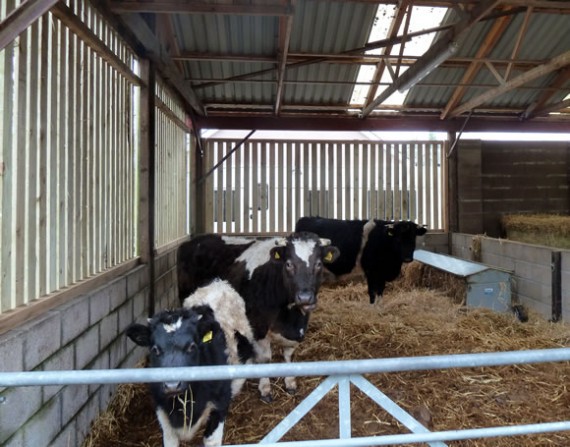Housing cattle
In general, the British traditional breeds do not need to be housed in winter if they have adequate shelter in the field and sufficient forage, as the breeds have evolved to suit our climate but if the land is wet, there is a real likelihood that it will be damaged by poaching (the action of hooves or tyres on wet soil), especially round water troughs, gates and feed areas.
You will also have to feed your cattle over winter – and in bad weather it can be difficult and even dangerous to access the feeding area – so it’s worth considering housing, even for part of the winter.
 We use part of our barn for housing some of the cattle over winter.
We use part of our barn for housing some of the cattle over winter.
In the dairy sector today, it is usual practice to loose house cattle in sheds with slatted floors (with slurry tanks underneath) and individual cubicles. In days past, milk cows would be tethered in individual stalls using neck chains, with fodder and water being carried to them and droppings carried away, with the cows’ movement restricted to standing up and lying down.
However, it is most likely that you will want to keep your cattle loose, in straw bedded courts or sheds. Although this is quite labour intensive, in that the bedding will need topped up regularly and the shed mucked out in spring, it’s a more natural way of housing cattle; you don’t need to invest in specialist buildings; you don’t have to worry about handling slurry and the cattle will make you some great farmyard manure (FYM) over winter.
Plus there is something wonderful about contented cattle, lying on clean straw, chewing the cud. :-)
Housing requirements
All cattle housing must provide sufficient comfortable, clean and dry lying space on a solid base. Ideally, groups of housed cattle should be of similar size (younger, smaller animals find it harder to compete for food) and if you have any particularly aggressive animals, they should be housed separately.
If you are housing cows with calves at foot, it’s worth thinking about setting up a creep area that only the calves can access.
The space standards below come from the Soil Association and are a useful guide:
Breeding and fattening cattle
| Liveweight (kg) | Lying area or indoor area (m² / head)* | Additional space required (m² / head)** | Total m² per head |
|---|---|---|---|
| Up to 100kg | 1.5 | 1.1 | 2.6 |
| Up to 200kg | 2.5 | 1.1 | 4.4 |
| Up to 300kg | 4.0 | 3.0 | 7.0 |
| 350 – 500kg | 5.0 | 3.7 | 8.7 |
| Above 500kg | 1m² / 100kg | 0.75m² / 100kg | 1.75m² / 100kg |
| * This is the minimum lying area (under cover and bedded) for loose houses or the total indoor area for cubicle housing. Cattle with horns should have additional space available. | |||
| ** This additional area can be indoors or outdoors. | |||
Source: Soil Association Organic Standards August 2012
The most common bedding for cattle is straw, although in the dairy sector rubber mats are widely used in cubicles, usually with some bedding (sawdust or sand, for example) on top.
I’ve found that now that we’re feeding straw, the cattle more or less bed themselves.
In designing your cattle housing, you will need to make provision for feeding and watering. If you can have running water to troughs, it will make life much easier for you (except when they freeze).
Ventilation is also important. Insufficient airflow can predispose cattle, especially young cattle, to pneumonia. Some farmers clip the winter coat from along the cattle’s spine so that they don’t overheat, sweat and become damp as a result.
If you do decide to house your cattle, you will need to consider how you are going to store / use / dispose of the muck that will be produced.
- Previous « Feeding cattle
- Next Fencing for cattle »

About Rosemary Champion
Rosemary lives on a 12 acre smallholding in Angus, in the east of Scotland, where she keeps Ryeland Sheep, Shetland cattle and assorted poultry. She was destined to be a smallholder from an early age.
Further Reading
 Caring for Cows Val Porter |  Practical Cattle Farming Kat Bazeley |  The Illustrated Guide to Cows Celia Lewis |  Cows for the Smallholder Val Porter |  |













